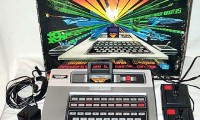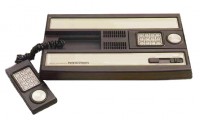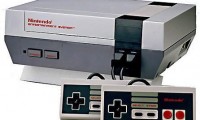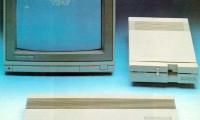
I spent the better part of my formative years during the 8-bit era of gaming. In that period, I owned 4 different gaming systems and one glorified gaming computer: Odyssey2, Intellivision, ColecoVision, Nintendo Entertainment System (NES), and a Commodore 128 computer that was essentially a Commodore 64 with an additional “business” use. Following is a nostalgic trip through my first gaming years.

Odyssey2
My first ever console was a used (I was 3 when they launched originally) Odyssey2, which was produced by Phillips/Magnavox. With a powerful Intel 8048 processor (40 whole pins!), and a dedicated audio/video processor, the Odyssey2 was able to render stunning 160x200pixel images in vibrant 4-bit color (16 pre-defined colors, of which any individual sprite could only use 8). With massive 8kB cartridges, the amount of depth and immersion game developers were able to create was simply staggering.
In all honesty, I barely remember using this console, as I was so very young when we got it. I do have a few flashes here and there of a F1 racing-style game, and a couple of learning games in my memory, but that’s about it, really. The biggest thing I remember was that the cartridges all had handles, which made it easy to pop them in and out.

Intellivision
Its name a clever little mash-up of “Intelligent Television”, Intellivision was another one of those systems that I barely remember. Like the Odyssey2, it was launched quite early in my gaming career, and was probably picked up used. Even though it fits squarely in the 8-bit era, the Intellivision was (to my surprise upon researching here) actually a 16-bit console. However, the single processor was responsible for all functions of the unit, with no help from dedicated video or audio processors.
The stand-out feature of Intellivision was its ability to download games over cable TV. This came with a few caveats, of course: You had to have cable TV, your provider had to support such downloads (ours did not, if I recall correctly), and you had to re-download any games every time the console was restarted.

ColecoVision
My ColecoVision still sits in my mom’s basement, and still functions today as far as I know. I can’t even imagine the number of hours I spent in front of that console (primarily playing Smurfs: Rescue in Gargamel’s Castle and Donkey Kong), but I can guarantee it would be considered “Far more than healthy” by today’s standards. Sporting a blazing Zilog Z80A processor clocked at a blistering 3.58MHz, the ColecoVision was the king of the 8-bit era at the time. Gorgeously rendered 256×192 images graced the screen in delicious 4-bit color (all of which could be used at once, a huge improvement over the Odyssey2).
By the end of its run, ColecoVision had an massive library of 145 games, impressive for the early 1980s. Most notably, however, was the first of its expansion modules named (appropriately enough) “Expansion Module #1”. Expansion Module #1 provided 100% compatibility with any Atari 2600 cartridge, instantly giving ColecoVision the largest gaming library available at the time. A ruling against Atari in a subsequent lawsuit (Atari essentially used off-the-shelf parts to build the 2600) allowed Coleco to go even farther and market their own version of the 2600 called “Gemini”.

Nintendo Entertainment System
In 1985, Nintendo launched the Nintendo Entertainment System (NES), a US and European version of its Famicom (Family Computer) console. The NES promptly took the US gaming market by storm and destroyed all competitors for quite some time. Even accounting for its many well-documented annoyances (who here has had to blow on their cartridges more times than they wish to think about?), the NES completely dominated the video game market for several years.
As for my gaming career, I received my NES quite late in the game. By that time, I had already moved up to the world of PC gaming with my ridiculously fast 66MHz 486 desktop. I picked it up from a friend who was saving money for the highly-anticipated 16-bit SuperNES. The NES was a nice in-room diversion where I logged many hours on Super Mario Brothers, Duck Hunt, and Batman. One of my strongest memories of my NES was getting toward the end of Batman and pausing it so I could go to bed without having to restart the level.
Commodore 64/128

Finally, we reach the end of my 8-bit journey with my beloved Commodore 128. A direct descendant of the venerable Commodore 64, the 128 offered twice the system RAM and a faster processor than its older brother. Unfortunately for gaming, this meant nothing, as the 128 needed to be booted into 64 mode in order to play just about anything at all. The 128 didn’t really do anything truly notable when taking into account everything the 64 already did. As such, when I refer to it in conversation with others, I do so simply as though it was a 64.
This is not to say I didn’t really enjoy that machine. To this day, I think I logged more time at the keyboard of that Commodore than any other home computer I’ve ever personally owned. Most of that time was with a little game called Questron; a classic RPG/exploring/adventure title. The advent of BBS systems and my first forays into pirating created for me a collection of well over 300 games and other software titles, most of which never got touched in favor of my beloved Questron.
Looking back on this short history of my gaming leads me to one primary conclusion: I had a LOT of time on my hands in those early days. I wonder what I could have done with my life with all of that extra time.


2 Comments